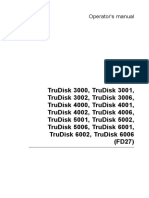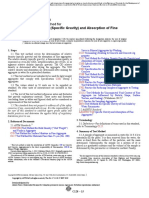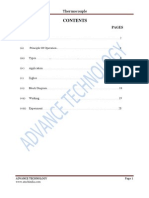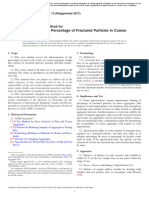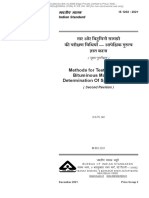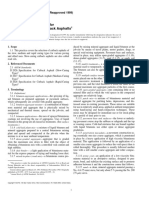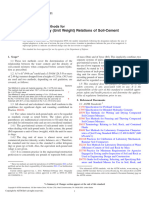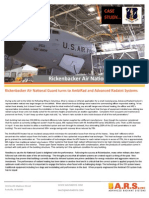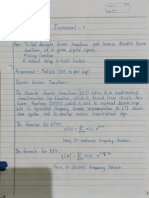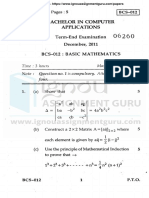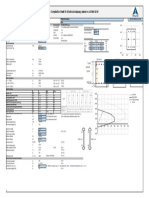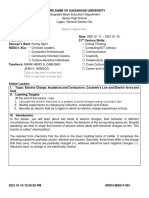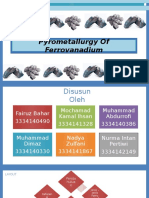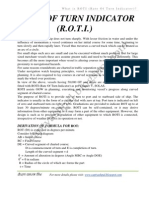Calibration of Laboratory Mechanical-Rammer Soil Compactors: Standard Practices For
Calibration of Laboratory Mechanical-Rammer Soil Compactors: Standard Practices For
Uploaded by
Abid HussainCopyright:
Available Formats
Calibration of Laboratory Mechanical-Rammer Soil Compactors: Standard Practices For
Calibration of Laboratory Mechanical-Rammer Soil Compactors: Standard Practices For
Uploaded by
Abid HussainOriginal Title
Copyright
Available Formats
Share this document
Did you find this document useful?
Is this content inappropriate?
Copyright:
Available Formats
Calibration of Laboratory Mechanical-Rammer Soil Compactors: Standard Practices For
Calibration of Laboratory Mechanical-Rammer Soil Compactors: Standard Practices For
Uploaded by
Abid HussainCopyright:
Available Formats
Designation: D2168 – 10
Standard Practices for
Calibration of Laboratory Mechanical-Rammer Soil
Compactors1
This standard is issued under the fixed designation D2168; the number immediately following the designation indicates the year of
original adoption or, in the case of revision, the year of last revision. A number in parentheses indicates the year of last reapproval. A
superscript epsilon (´) indicates an editorial change since the last revision or reapproval.
This standard has been approved for use by agencies of the Department of Defense.
1. Scope* mass (lbm) or the recording of density in lbm/ft3 shall not be
1.1 These practices for the calibration of mechanical soil regarded as a nonconformance with this standard.
compactors are for use in checking and adjusting mechanical 1.6 This standard does not purport to address all of the
devices used in laboratory compacting of soil and soil- safety concerns, if any, associated with its use. It is the
aggregate in accordance with Test Methods D698, D1557, responsibility of the user of this standard to establish appro-
Practice D6026, and other methods of a similar nature that priate safety and health practices and determine the applica-
might specify these practices. Calibration for use with one bility of regulatory limitations prior to use.
practice does not qualify the equipment for use with another
2. Referenced Documents
practice.
1.2 The weight of the mechanical rammer is adjusted as 2.1 ASTM Standards:2
described in 5.4 and 6.5 in order to provide for the mechanical D653 Terminology Relating to Soil, Rock, and Contained
compactor to produce the same result as the manual compactor. Fluids
1.3 Two alternative procedures are provided as follows: D698 Test Methods for Laboratory Compaction Character-
Section
istics of Soil Using Standard Effort (12 400 ft-lbf/ft3(600
Practice A Calibration based on the compaction of a 5 kN-m/m3))
selected soil sample D1557 Test Methods for Laboratory Compaction Charac-
Practice B Calibration based on the deformation of a 6
standard lead cylinder
teristics of Soil Using Modified Effort (56,000 ft-lbf/
ft3(2,700 kN-m/m3))
1.4 If a mechanical compactor is calibrated in accordance D2487 Practice for Classification of Soils for Engineering
with the requirements of either Practice A or Practice B, it is Purposes (Unified Soil Classification System)
not necessary for the mechanical compactor to meet the D3740 Practice for Minimum Requirements for Agencies
requirements of the other practice. Engaged in Testing and/or Inspection of Soil and Rock as
1.5 The values stated in inch-pound units are to be regarded Used in Engineering Design and Construction
as the standard. The values given in parentheses are for D6026 Practice for Using Significant Digits in Geotechnical
information only. Data
1.5.1 It is common practice in the engineering profession to E11 Specification for Woven Wire Test Sieve Cloth and Test
concurrently use pounds to represent both a unit of mass (lbm) Sieves
and a force (lbf). This implicitly combines two separate E145 Specification for Gravity-Convection and Forced-
systems of units; that is, the absolute system and the gravita- Ventilation Ovens
tional system. It is scientifically undesirable to combine the use
of two separate sets of inch-pound units within a single 3. Significance and Use
standard. This standard has been written using the gravitational 3.1 Mechanical compactors are commonly used to replace
system of units when dealing with the inch-pound system. In the hand compactors required for Test Methods D698 and
this system, the pound (lbf) represents a unit of force (weight). D1557 in cases where it is necessary to increase production.
However, the use of balances or scales recording pounds of 3.2 The design of mechanical compactors is such that it is
necessary to have a calibration process that goes beyond
1
determining the mass and drop of the hammer.
These practices are under the jurisdiction of ASTM Committee D18 on Soil and
Rock and are the direct responsibility of Subcommittee D18.03 on Texture,
2
Plasticity and Density Characteristics of Soils. For referenced ASTM standards, visit the ASTM website, www.astm.org, or
Current edition approved July 1, 2010. Published August 2010. Originally contact ASTM Customer Service at service@astm.org. For Annual Book of ASTM
apprroved in 1990. Last previous edition approved in 2002 as D2168–02a. DOI: Standards volume information, refer to the standard’s Document Summary page on
10.1520/D2168-10. the ASTM website.
*A Summary of Changes section appears at the end of this standard.
Copyright. (C) ASTM International. 100 Barr Harbour Drive, PO box C700 West Conshohocken, PA United States
Copyright by ASTM Int'l (all rights reserved); 1
D2168 – 10
NOTE 1—The quality of the result produced by this standard is mechanical compactor is to be calibrated. Operate the compac-
dependent on the competence of the personnel performing it, and the tor for a minimum of 25 drops to cause friction in the parts to
suitability of the equipment and facilities used. Agencies that meet the become constant, allowing the rammer to fall on soil or other
criteria in Practice D3740 are generally considered capable of competent
and objective testing/sampling/inspection/and the like. Users of this
soft material.
standard are cautioned that compliance with Practice D3740 does not in NOTE 3—In order to provide satisfactory results, mechanical compac-
itself assure reliable results. Reliable results depend on many factors; tors must be in excellent working condition. Improper operation of the
Practice D3740 provides a means of evaluating some of those factors. raising and release mechanisms can introduce serious errors.
4. Apparatus 5.2 Obtain approximately 50 lb (23 kg) of soil classified as
4.1 For Practice A, in addition to the apparatus requirements CL in accordance with Classification D2487. If excessive
specified in Test Methods D698 and D1557, the following is moisture is present, dry the soil until it becomes friable. Drying
required: may be in air or by use of a drying apparatus such that the
4.1.1 Drying Oven——Thermostatically controlled oven, temperature of the sample does not exceed 140°F (60°C). Pass
preferably of the forced-draft type, meeting the requirements the soil through a No. 4 (4.75-mm) sieve conforming to the
for Specification E145 and capable of maintaining a uniform requirements of Specification E11. Discard any material re-
temperature of 140 6 5°F (60 6 3°C) throughout the drying maining on the sieve, and thoroughly blend the material
chamber. passing the sieve until it is uniform. The material shall then be
4.2 For Practice B, in addition to the apparatus requirements prepared for compaction in accordance with either Methods
specified in Test Methods D698 and D1557, the following are D698 or D1557 as appropriate for the mechanical compactor
required: being calibrated.
4.2.1 Lead Deformation Apparatus—A lead deformation NOTE 4—The amount of soil used will vary greatly depending on the
apparatus consisting of an anvil, guide collar, and striking pin, number of water content unit mass determinations required.
as shown in Fig. 1.
4.2.2 Micrometer—A one-inch (25-mm) outside microme- 5.3 Using the soil prepared in accordance with 5.2, deter-
ter or caliper reading to 0.001 in. (0.02 mm), for determining mine optimum moisture and maximum dry unit weight by
the length of the lead cylinders. As an alternative, a one-inch Method A of either Test Methods D698 or D1557 or whichever
(25-mm) dial comparator reading to 0.001 in. (0.02 mm) may method is appropriate for the mechanical compactor being
be used to determine either the length of the lead cylinder, or calibrated. Prepare one curve using the mechanical compactor
of the complete lead deformation apparatus assembly. To and another using the manual compactor. Record the values of
measure the complete assembly, a dial comparator with a gmax, the maximum dry unit weight obtained with the manual
minimum opening of 2 in. (50 mm) is required (see Fig. 2). compactor, and g8max, the maximum dry unit weight obtained
with the mechanical compactor.
NOTE 2—The use of vernier calipers is not recommended since the
5.4 Determine W, the percentage difference of maximum
vernier calipers can produce erroneous readings if not zeroed correctly, or
if the vernier caliper is not of high quality. dry unit weight values for a single set of data (see Section 7).
If the absolute value of W is equal to or less than 2.0, the
4.2.3 Guide Sleeve Pedestal—A guide sleeve pedestal for mechanical compactor is satisfactory for immediate use. If the
use with guide sleeves used to control the drop of the manual absolute value of W is greater than 2.0, then obtain two
rammers in Test Methods D698 and D1557 (see Fig. 3). additional sets of data. Use the same soil sample, prepared in
4.2.4 Test Cylinders—A supply of commercially pure lead accordance with 5.2, that was used previously. Determine W,
test cylinders having individual weights such that the lightest the average percentage difference of maximum dry unit mass
cylinder is within 0.06 g of the heaviest, each having a length values for three sets of data (see Section 7). If the absolute
of 0.675 6 0.005 in. (17.1 6 0.1 mm) and a diameter of 0.310 value of W is equal to or less than 2.0, the mechanical
6 0.002 in. (7.87 6 0.05 mm).3 A minimum of ten test compactor is satisfactory for immediate use. If the absolute
cylinders is required for the calibration of one mechanical value of W̄ is greater than 2.0, then adjust the rammer mass
compactor. However, depending on circumstances, as many as of the mechanical compactor in accordance with 5.5. Then
100 test cylinders may be required. secure three new values of g8max and compute a new value of
5. Procedure—Practice A W̄. Repeat this procedure until the absolute value of W̄ is equal
to or less than 2.0.
5.1 Evaluate the mechanical and manual compactors for
5.5 Make changes in the weight of the mechanical hammer
evidence of wear, malfunction, and need of servicing and
with due consideration to good workmanship. Makeshift modi-
adjustment. Clean, adjust, and lubricate the compactors so as to
fications that could affect the operation of the mechanical
meet all requirements of the manufacturer, and the applicable
compactor are not permitted. The maximum permissible varia-
method under which they will be used and for which the
tion in the weight of the mechanical hammer as the result of
calibration is as follows: The total mass added to the original
3
The sole source of supply of the lead test cylinders known to the committee at mass of the hammer as received from the manufacturer must
this time is Hornady Manufacturing Co., P.O. Box 1848, Grand Island, Nebr. 68801 not exceed ten percent of its original mass. If it is necessary to
in lots of 500. If you are aware of alternative suppliers, please provide this
information to ASTM International Headquarters. Your comments will receive
add more than ten percent, The mechanical compactor is to be
careful consideration at a meeting of the responsible technical committee,1 which rebuilt or repaired. If the calibration indicates that the mass of
you may attend. the original rammer needs to be reduced to less than 5.5 lbf
Copyright by ASTM Int'l (all rights reserved); 2
D2168 – 10
in. mm
2.10 53.34
1 7⁄8 48
1 5⁄8 41
1 1⁄2 38
1.250 31.75
1.248 31.70
0.626 15.90
0.625 15.88
1 ⁄2 13
0.317 8.05
1 ⁄4 6.4
1 ⁄8 3.2
1⁄16 1.6
1⁄32 0.79
0.005 0.13
0.004 0.10
0.002 0.05
0.001 0.02
NOTE 1—Inside dimension of guide collar should slip easily over raised section of anvil without excessive free play. Anvil should slip easily inside
guide sleeve pedestal without excessive free play.
FIG. 1 Lead Deformation Apparatus
(2.49 kg) or 10 lbf (4.54 kg) depending on the test method NOTE 5—Graphical procedures are helpful in estimating the correct
rammer standard, carefully recheck all equipment and calibra- amount of mass to be added or subtracted.
tions and report the procedure. If removal of mass is still 5.6 If a larger change than that permitted in 5.5 is found to
indicated, the height-of-drop should be adjusted. be necessary, then improper operation of the mechanical
Copyright by ASTM Int'l (all rights reserved); 3
D2168 – 10
compactor is indicated. Evaluate and adjust the mechanical
compactor in order to determine and eliminate the cause of the
malfunction and repeat the calibration procedure.
5.7 Do not use the mechanical compactor if the indicated
weight change still exceeds that permitted in 5.5.
6. Procedure—Practice B
6.1 Evaluate and adjust the mechanical and manual com-
pactors as described in 5.1 of Practice A.
6.2 Deformation by the Manual Compactor—Obtain the
deformation value for the manual compactor as follows:
6.2.1 Select a set of lead cylinders from the same lot or
shipment. Remove any burrs from the ends of the lead
cylinders using a fine grade of emery cloth.
NOTE 6—Deformation of the lead cylinders is affected by changes in
temperature. Take precautions to maintain the cylinders within 65°F
(62.7°C) during the calibration of the mechanical compactor and the
securing of the manual compactor values.
in. mm 6.2.2 Obtain c1, the (initial) micrometer or dial comparator
8 203 reading before impact, following the procedures decribed in
3 76 6.2.5.
2 51
1 25 6.2.3 Place the base plate of the compaction mold on a rigid
1⁄ 4 6.4 foundation. On the base plate, place the assembled lead
1⁄ 8 3.2 deformation apparatus with the lead cylinder (see Fig. 4) and
0.001 0.02
guide sleeve pedestal in place. Insert the guide sleeve of the
FIG. 2 Dial Comparator manual compactor into the recess in the guide sleeve pedestal.
Check that the distance from rammer release point to striking
pin contact meets the specified requirements. Apply one drop
of the manual rammer with the guide sleeve of the manual
compactor held vertically, so that the rammer does not strike
the guide sleeve pedestal.
6.2.4 Obtain c2, the micrometer or dial comparator reading
after impact, following the procedures described in 6.2.5. The
difference between dial readings c1 and c2 is equal to D, the
deformation value.
6.2.5 Obtain readings for c1 and c2 either by:
6.2.5.1 Direct measurement of the length of the lead cylin-
der, using the outside micrometer caliper or an equivalent dial
comparator.
in. mm
2.77 70.4
2.13 54.10
3⁄ 8 10
1⁄ 8 3.2
0.03 0.8
0.005 0.13
NOTE 1—This dimension must be equal to the height of the lead
deformation apparatus when assembled with the lead cylinder in place,
within a tolerance of 60.01 in. (60.25mm).
NOTE 2—Diameter A is such that guide sleeve of rammer fits easily into
recess without free play.
FIG. 3 Guide Sleeve Pedestal
FIG. 4 Lead Deformation Apparatus Assembly
Copyright by ASTM Int'l (all rights reserved); 4
D2168 – 10
6.2.5.2 Obtaining a measurement of the assembled defor- W̄ = average percentage difference of maximum unit
mation apparatus, secured by placing it in the dial comparator weight values for three sets of data,
so that the top center of the 1⁄4-in. (6.4-mm) steel ball of the gmax = maximum unit weight value obtained by the
striking pin is directly under the tip of the dial stem. manual method,
6.2.6 Repeat 6.2.2-6.2.5 using an unused lead cylinder for ḡmax = average of three maximum unit weight values
each determination until five deformation values are obtained obtained by the manual method,
that do not vary more than 2.0 % from D̄, the average value; g8max = maximum unit weight value obtained by the
that is, the absolute value of v1 must be less than 2.0 for the five mechanical method, and
values selected (see 7.2). The deformation value for the manual ḡ8max = average of three maximum unit weight values
method shall be taken as D̄. obtained by the mechanical method.
6.3 Deformation by the Mechanical Compactor—Obtain 7.2 Calculate the percentage difference of average lead
the deformation value (change in height) of the lead cylinder deformation values as follows:
by the mechanical compactor as follows: D 5 c1 2 c2 (2)
6.3.1 Select a set of at least five lead cylinders from the
same lot or shipment. Remove any burrs from the ends of the D̄ 5 (~c1 2 c2!/N
lead cylinders using a fine grade emery cloth (see Note 6). D8 5 c81 2 c82
6.3.2 Place the assembled lead deformation apparatus on the D̄8 5 (~c81 2 c82!/N
base of the mechanical compactor at such location that the
striking pin will be centered on the face of the rammer at the n1@D 2 D̄!/ D̄] 3 100
moment of contact of the two. n81 5 [~D8 2 D̄8!/ D̄8] 3 100
6.3.3 Obtain the average deformation value D̄8 for the
n2 5 [~ D̄ 2 D̄8!/ D̄# 3 100
mechanical compactor using the same procedure specified in
6.2, except do not use the guide sleeve pedestal. The mechani- where:
cal compactor must operate in the normal manner so as to lift c1 = micrometer or dial comparator reading before
the rammer from the striking pin contact elevation to the impact, manual rammer,
specified release height. Raising and releasing the rammer c2 = micrometer or dial comparator reading after
manually or by any procedure other than that of normal impact, manual rammer,
automatic operation is prohibited. It may be beneficial to c81 = micrometer or dial comparator reading before
temporarily suspend operation of the automatic turntable impact, mechanical rammer,
during the calibration procedure. c82 = micrometer or dial comparator reading after
6.3.4 Repeat 6.3.2 and 6.3.3 on remaining lead cylinders in impact, mechanical rammer,
set. D = deformation value for single lead cylinder,
6.4 Calculate v2, the percentage difference of the average manual rammer,
deformation value, using the mechanical rammer, from the D8 = deformation value for single lead cylinder,
average deformation value, using the manual rammer (see 7.2). mechanical rammer,
If v2 does not vary more than 62.0, then the mechanical D̄ and D̄8 = average deformation values for manual and
compactor is satisfactory for immediate use. mechanical rammers respectively, where v1
6.5 If v2 exceeds6 2.0, repeat 6.3.2 and 6.3.3, securing two and v81 values do not exceed 62.0 %,
additional values of v2. Average the absolute value of all three n1 = percentage variation from the mean of indi-
values of v2. If this average is equal to or less than 2.0, the vidual deformation values obtained using the
mechanical compactor is satisfactory for immediate use. If the manual rammer,
absolute mean value of v2 is greater than 2.0, then adjust the n81 = percentage variation from the mean of indi-
rammer weight of the mechanical rammer in accordance with vidual deformation values obtained using the
5.5 and obtain additional sets of mechanical compactor data mechanical rammer,
until the mean value of v2 for three sets of data is equal to or n2 = percentage difference of the average deforma-
less than 2.0. tion value using the mechanical rammer from
6.6 Follow the same procedure as described for Practice A the average deformation value using the
in 5.5, 5.6, and 5.7. manual rammer, and
N = number of tests.
7. Calculations
8. Report
7.1 Calculate the percentage difference of maximum unit
weight values as follows: 8.1 The report shall include the following information:
W 5 [~g8max 2 gmax!/gmax# 3 100 (1) 8.1.1 Identification of laboratory compactor by make,
model, and serial number,
W̄ 5 [~ḡ8max 2 ḡmax!/ḡmax# 3 100
8.1.2 ASTM designation of laboratory compaction proce-
where: dure for which the compactor was calibrated,
W = percentage difference of maximum unit weight 8.1.3 Date of calibration,
values for a single set of data,
8.1.4 Practice used (A or B),
Copyright by ASTM Int'l (all rights reserved); 5
D2168 – 10
8.1.5 For Practice A only: classification of soil used by 9. Precision and Bias
Classification D2487, 9.1 These practices describe calibration methods that do not
8.1.6 For Practice A only: experimental values of gmax and produce a test result; therefore, neither a precision or bias
g8max, statement is applicable.
8.1.7 For Practice B only: experimental values of c1, c81, c2,
and c82, 10. Keywords
8.1.8 Calculations, and 10.1 laboratory compaction; mechanical rammer; moisture
8.1.9 Initial and adjusted weights of rammer. density
SUMMARY OF CHANGES
Committee D18 has identified the location of selected changes to these practices since the last issue,
D2168–02a, that may impact the use of these practices. (Approved July 1, 2010)
(1) Added Practice D6026 to Scope and Referenced Docu- (5) Revised 5.5. Deleted old Note 5 and renumbered subse-
ments. quent notes.
(2) Added new 1.5.1. (6) Added a statement regarding turntable in 6.3.3.
(3) Replaced “thoroughly inspect” and “carefully inspect” with
(7) Changed the standard from “Test Methods” to “Practices”
“evaluate” throughout.
throughout.
(4) Added tolerances to 4.2.2.
ASTM International takes no position respecting the validity of any patent rights asserted in connection with any item mentioned
in this standard. Users of this standard are expressly advised that determination of the validity of any such patent rights, and the risk
of infringement of such rights, are entirely their own responsibility.
This standard is subject to revision at any time by the responsible technical committee and must be reviewed every five years and
if not revised, either reapproved or withdrawn. Your comments are invited either for revision of this standard or for additional standards
and should be addressed to ASTM International Headquarters. Your comments will receive careful consideration at a meeting of the
responsible technical committee, which you may attend. If you feel that your comments have not received a fair hearing you should
make your views known to the ASTM Committee on Standards, at the address shown below.
This standard is copyrighted by ASTM International, 100 Barr Harbor Drive, PO Box C700, West Conshohocken, PA 19428-2959,
United States. Individual reprints (single or multiple copies) of this standard may be obtained by contacting ASTM at the above
address or at 610-832-9585 (phone), 610-832-9555 (fax), or service@astm.org (e-mail); or through the ASTM website
(www.astm.org). Permission rights to photocopy the standard may also be secured from the ASTM website (www.astm.org/
COPYRIGHT/).
Copyright by ASTM Int'l (all rights reserved); 6
You might also like
- TruDisk Laser Operating Manual PDFDocument286 pagesTruDisk Laser Operating Manual PDFjulio perez0% (2)
- Fly or Drive LabDocument6 pagesFly or Drive LabMrWardTeachesNo ratings yet
- ASTM 4867 (Reapproved 2014) Standard Test Method For Effect of Moisture On Asphalt Concrete Paving MixturesDocument5 pagesASTM 4867 (Reapproved 2014) Standard Test Method For Effect of Moisture On Asphalt Concrete Paving MixturesErnesto Oscar VidelaNo ratings yet
- Astm C128Document7 pagesAstm C128Maria Bernal100% (1)
- Cutback Asphalt (Rapid-Curing Type) : AashloDocument3 pagesCutback Asphalt (Rapid-Curing Type) : AashloNacer KisyNo ratings yet
- Thermocouple ManualDocument20 pagesThermocouple Manualprateekgupta900No ratings yet
- 4.OA.1 Task 1Document5 pages4.OA.1 Task 1Nur NadzirahNo ratings yet
- Preparation of Test Specimens of Asphalt-Stabilized Soils: Standard Practice ForDocument5 pagesPreparation of Test Specimens of Asphalt-Stabilized Soils: Standard Practice Forโก อู๋No ratings yet
- Sieve Analysis of Mineral Filler For Asphalt Paving MixturesDocument2 pagesSieve Analysis of Mineral Filler For Asphalt Paving MixturesAnonymous x7VY8VF7No ratings yet
- Compressive Strength of Molded Soil-Cement Cylinders: Standard Test Methods ForDocument4 pagesCompressive Strength of Molded Soil-Cement Cylinders: Standard Test Methods ForManuel Enrique VásquezNo ratings yet
- Determining The Percentage of Fractured Particles in Coarse AggregateDocument6 pagesDetermining The Percentage of Fractured Particles in Coarse AggregateJimmy Johan Tapia VásquezNo ratings yet
- Moisture-Density (Unit Weight) Relations of Soil-Cement MixturesDocument7 pagesMoisture-Density (Unit Weight) Relations of Soil-Cement MixturesHandy100% (1)
- Air Content of Freshly Mixed Concrete by The Volumetric MethodDocument9 pagesAir Content of Freshly Mixed Concrete by The Volumetric MethodSupervisión Durango MazatlanNo ratings yet
- C490 Practice For Use of Apparatus For The Determination ofDocument5 pagesC490 Practice For Use of Apparatus For The Determination ofCarineMolzNo ratings yet
- Preparation of Asphalt Mixture Specimens Using Marshall ApparatusDocument8 pagesPreparation of Asphalt Mixture Specimens Using Marshall Apparatussumukh swaroopNo ratings yet
- D2172D2172M 17Document10 pagesD2172D2172M 17mehdiNo ratings yet
- C637-14 Standard Specification For Aggregates For Radiation-Shielding ConcreteDocument4 pagesC637-14 Standard Specification For Aggregates For Radiation-Shielding ConcreteFahad RedaNo ratings yet
- Astm d2172Document10 pagesAstm d2172radhaNo ratings yet
- Determining The Rheological Properties of Asphalt Binder Using A Dynamic Shear RheometerDocument16 pagesDetermining The Rheological Properties of Asphalt Binder Using A Dynamic Shear RheometerRahul HnkNo ratings yet
- Aashto Pp-14 (2018) Diseño OgfcDocument9 pagesAashto Pp-14 (2018) Diseño OgfcMario Esteban Solano RodriguezNo ratings yet
- Electrical Indication of Concrete's Ability To Resist Chloride Ion PenetrationDocument8 pagesElectrical Indication of Concrete's Ability To Resist Chloride Ion PenetrationSofía Córdoba SáenzNo ratings yet
- Compressive Strength of Bituminous Mixtures: Standard Test Method ForDocument5 pagesCompressive Strength of Bituminous Mixtures: Standard Test Method Foraastha mehtaNo ratings yet
- Astm D2726-17Document4 pagesAstm D2726-17Iranis E Lugo RodriguezNo ratings yet
- Agencies Testing Concrete and Concrete Aggregates For Use in Construction and Criteria For Testing Agency EvaluationDocument9 pagesAgencies Testing Concrete and Concrete Aggregates For Use in Construction and Criteria For Testing Agency EvaluationCory Bradley100% (1)
- Amount of Water Required For Normal Consistency of Hydraulic Cement PasteDocument3 pagesAmount of Water Required For Normal Consistency of Hydraulic Cement PasteThurain Aung KyawNo ratings yet
- D 88 - D 88M - 07 (2019)Document7 pagesD 88 - D 88M - 07 (2019)jamie courneyNo ratings yet
- Bulk Specific Gravity and Density of Non-Absorptive Compacted Asphalt MixturesDocument4 pagesBulk Specific Gravity and Density of Non-Absorptive Compacted Asphalt MixturesKev SantiagoNo ratings yet
- Aashto M323-13Document12 pagesAashto M323-13JUAN RAMIREZNo ratings yet
- Aashto T217-14 (2022)Document7 pagesAashto T217-14 (2022)jaheshfarhadNo ratings yet
- Astm D244-09 (R 2017)Document9 pagesAstm D244-09 (R 2017)Alexandru LetNo ratings yet
- Astm D6910 D6910M 19Document2 pagesAstm D6910 D6910M 19tomNo ratings yet
- AASHTO T283-22 Standard Method of Test For Resistance of Compacted Asphalt Mixtures To Moisture-Induced DamageDocument11 pagesAASHTO T283-22 Standard Method of Test For Resistance of Compacted Asphalt Mixtures To Moisture-Induced DamageErnesto Oscar VidelaNo ratings yet
- PDF Astm d4402 DDDocument3 pagesPDF Astm d4402 DDKAKA MADAFAKANo ratings yet
- D2216 2236Document7 pagesD2216 2236Mohan GowdaNo ratings yet
- Astm D1883-16Document14 pagesAstm D1883-16Andrés Grefa JaraNo ratings yet
- ASTM D 546 Sieve Analysis of Mineral Filler For Bituminous Paving MixturesDocument2 pagesASTM D 546 Sieve Analysis of Mineral Filler For Bituminous Paving MixturesYasir DharejoNo ratings yet
- Determining Demulsibility of Emulsified Asphalt: Standard Test Method ForDocument2 pagesDetermining Demulsibility of Emulsified Asphalt: Standard Test Method ForROBERTO MIRANDANo ratings yet
- Length Change of Concrete Due To Alkali-Carbonate Rock ReactionDocument4 pagesLength Change of Concrete Due To Alkali-Carbonate Rock ReactionAntu IsabelNo ratings yet
- Consolidated Drained Triaxial Compression Test For SoilsDocument11 pagesConsolidated Drained Triaxial Compression Test For SoilsmickyfelixNo ratings yet
- Determination of Pore Volume and Pore Volume Distribution of Soil and Rock by Mercury Intrusion PorosimetryDocument8 pagesDetermination of Pore Volume and Pore Volume Distribution of Soil and Rock by Mercury Intrusion PorosimetryWanucy Barroso RodriguesNo ratings yet
- D 4867 - D 4867M - 04Document5 pagesD 4867 - D 4867M - 04Luisinho Alvarez ChávezNo ratings yet
- Methods For Testing Tar and Bituminous Materials - Determination of Specific GravityDocument10 pagesMethods For Testing Tar and Bituminous Materials - Determination of Specific Gravityturutriveni reddyNo ratings yet
- Chemical Admixtures For ConcreteDocument15 pagesChemical Admixtures For ConcreteKMNo ratings yet
- ASTM C 39 Standard Test Method For Compressive Strength of Cylindrical Concrete SpecimensDocument8 pagesASTM C 39 Standard Test Method For Compressive Strength of Cylindrical Concrete SpecimensMohamed HunaisNo ratings yet
- D4753 19711 PDFDocument6 pagesD4753 19711 PDFeduardo bonillaNo ratings yet
- Using Rock-Mass Classification Systems For Engineering PurposesDocument30 pagesUsing Rock-Mass Classification Systems For Engineering PurposesSFC ABHA 1100% (1)
- Evaluating, Selecting, and Specifying Balances and Standard Masses For Use in Soil, Rock, and Construction Materials TestingDocument6 pagesEvaluating, Selecting, and Specifying Balances and Standard Masses For Use in Soil, Rock, and Construction Materials TestingAhmedJardakNo ratings yet
- ASTM D5581 Resistance To Plastic Flow of Bituminous Mixtures Using MarshallDocument5 pagesASTM D5581 Resistance To Plastic Flow of Bituminous Mixtures Using MarshallVijayakrishna SingamsettiNo ratings yet
- ASTM D 4791 (Flat and Elongated Particles)Document8 pagesASTM D 4791 (Flat and Elongated Particles)Rafael EstradaNo ratings yet
- Density of Soil and Rock In-Place at Depths Below Surface by Nuclear MethodsDocument7 pagesDensity of Soil and Rock In-Place at Depths Below Surface by Nuclear MethodsIonut VasilescuNo ratings yet
- D5092D5092M 35156Document25 pagesD5092D5092M 35156Senor TodoNo ratings yet
- Aashto T193-22Document12 pagesAashto T193-22jaheshfarhadNo ratings yet
- Toaz - Info Astm c136 19 PRDocument5 pagesToaz - Info Astm c136 19 PRkhaleel100% (1)
- Astm C128 22Document4 pagesAstm C128 22Leon ZidaneNo ratings yet
- Is 8887 (2004) - Bitumen Emulsion For Roads (Cationic Type)Document17 pagesIs 8887 (2004) - Bitumen Emulsion For Roads (Cationic Type)arjun kumar50% (2)
- Portland Cement: Standard Specification ForDocument9 pagesPortland Cement: Standard Specification ForPedroNo ratings yet
- D 2041 D 2041M 11Document4 pagesD 2041 D 2041M 11gad100% (1)
- Penetration of Bituminous Materials: Standard Test Method ForDocument4 pagesPenetration of Bituminous Materials: Standard Test Method ForJanardhana ReddiNo ratings yet
- Astm D 4318Document16 pagesAstm D 4318Camilo OrozcoNo ratings yet
- Selection of Cutback Asphalts: Standard Practice ForDocument3 pagesSelection of Cutback Asphalts: Standard Practice ForMohamed Maamoun T.No ratings yet
- D2168 21269Document6 pagesD2168 21269D IZomer Oyola-Guzmán100% (1)
- D558-11 Standard Test Methods For Moisture-Density (Unit Weight) Relations of Soil-Cement MixturesDocument6 pagesD558-11 Standard Test Methods For Moisture-Density (Unit Weight) Relations of Soil-Cement MixturesMohammed AliNo ratings yet
- Moisture-Density (Unit Weight) Relations of Soil-Cement MixturesDocument6 pagesMoisture-Density (Unit Weight) Relations of Soil-Cement MixturesCarlos CmbbNo ratings yet
- D 558 - 11 PDFDocument6 pagesD 558 - 11 PDFCarmen CespedesNo ratings yet
- Lumix Camera Owners ManualDocument197 pagesLumix Camera Owners ManualMike GibbesNo ratings yet
- Questions On Concepts Q5.1) : and andDocument23 pagesQuestions On Concepts Q5.1) : and andAlejandra Fajardo ApoloNo ratings yet
- Rickenbacker Air National GuardDocument1 pageRickenbacker Air National GuardWhitney DavisNo ratings yet
- DSP Exp 4Document4 pagesDSP Exp 4Atharva PatilNo ratings yet
- BCS 012 Previous Year Question Papers by IgnouassignmentguruDocument79 pagesBCS 012 Previous Year Question Papers by IgnouassignmentguruJapani TutorNo ratings yet
- Online Homework 10-62NKDocument6 pagesOnline Homework 10-62NKHoang PhuonghaNo ratings yet
- DTS Pa1 01-2013 EngDocument3 pagesDTS Pa1 01-2013 EngJose Luis Barrueta HernandezNo ratings yet
- Analysis of LipidsDocument2 pagesAnalysis of LipidsHoney Joy Cruz CapiralNo ratings yet
- Rendekova, Yıl Belli DeğilDocument5 pagesRendekova, Yıl Belli DeğilMeriç EsenNo ratings yet
- Kshammeditation Amalananda PDFDocument14 pagesKshammeditation Amalananda PDFJayam Jai Maharaj100% (2)
- High Voltage Circuit Breakers Design and Applications 2E Ruben D GarzonDocument473 pagesHigh Voltage Circuit Breakers Design and Applications 2E Ruben D GarzonFeigin Leonid100% (1)
- Structural Adequacy Check F 010319 PDFDocument1 pageStructural Adequacy Check F 010319 PDFJames RoddNo ratings yet
- PHYS SCI 2024 National ANNUAL TEACHING PLAN GR 10 ENGDocument8 pagesPHYS SCI 2024 National ANNUAL TEACHING PLAN GR 10 ENGfanafisto04No ratings yet
- Breakers DRMDocument4 pagesBreakers DRMRana SarkarNo ratings yet
- ECN 2322-Lecture 1 ClassDocument25 pagesECN 2322-Lecture 1 ClassNeil NkhomaNo ratings yet
- EENG223 Ch06 Capacitors&InductorsDocument56 pagesEENG223 Ch06 Capacitors&InductorspunzNo ratings yet
- Chemical Engineering ThermodynamicsDocument2 pagesChemical Engineering ThermodynamicsShubham imtsNo ratings yet
- Introduction To The Tight Binding AproximationDocument34 pagesIntroduction To The Tight Binding AproximationGuillermo Alzaga BaixauliNo ratings yet
- Calibration Procedure - STUF-200HDocument1 pageCalibration Procedure - STUF-200HDiscovery St.OdiliaNo ratings yet
- Coralia AntenasDocument3 pagesCoralia AntenasALEX_125No ratings yet
- Week 1module StudentDocument12 pagesWeek 1module Studentkylie jonesNo ratings yet
- 1Document7 pages1विनय खरेNo ratings yet
- Pyrometallurgy of Ferro VanadiumDocument24 pagesPyrometallurgy of Ferro VanadiumNadyaZulfaniNo ratings yet
- ROTIDocument4 pagesROTIcaptyashpal100% (1)
- Diffuse Double LayerDocument14 pagesDiffuse Double LayerDhara LeeNo ratings yet
- Ficha Tecnica LG Mod. L8UC100BFA3Document7 pagesFicha Tecnica LG Mod. L8UC100BFA3Fabian Ariza ArizaNo ratings yet
